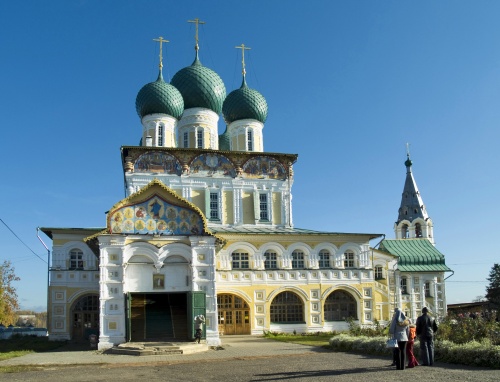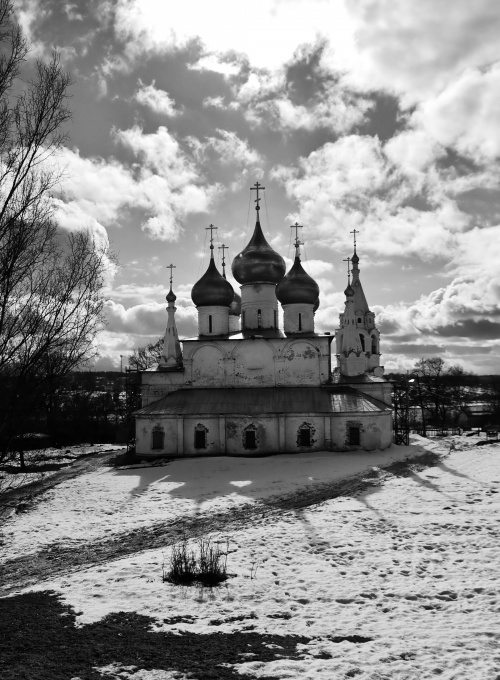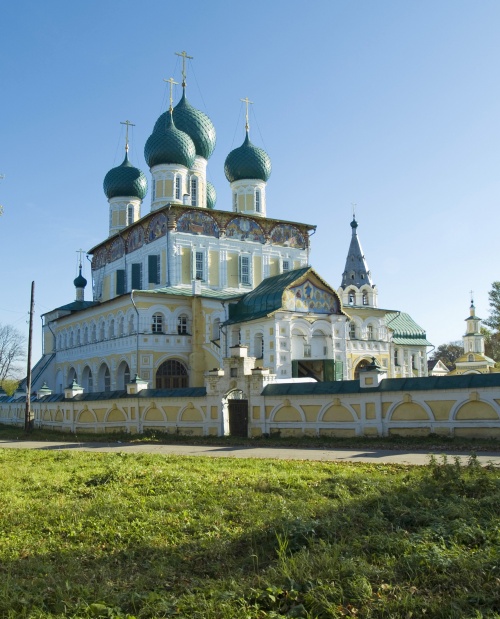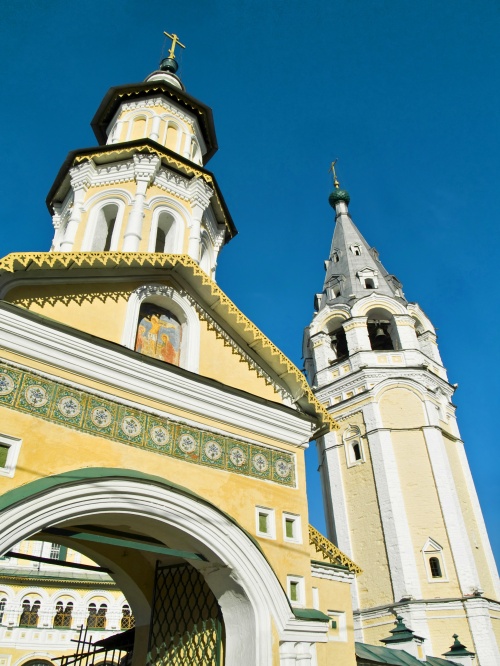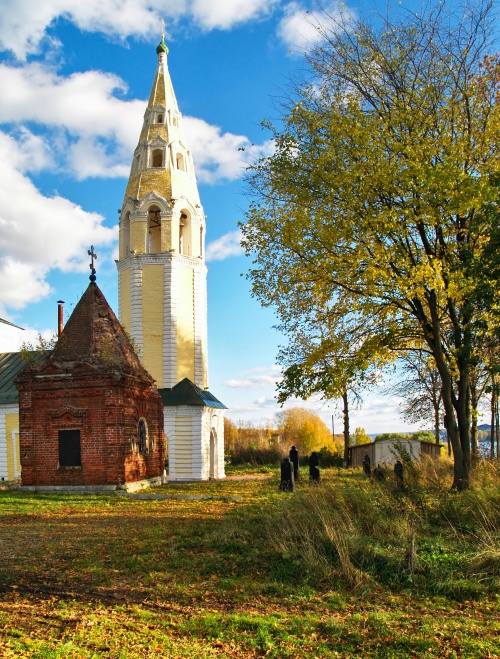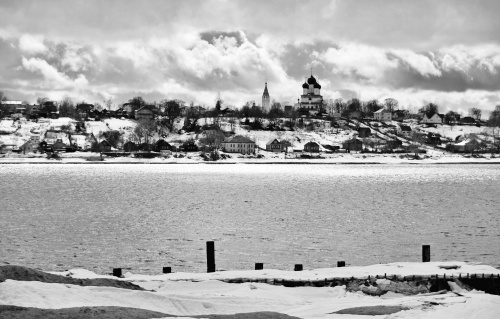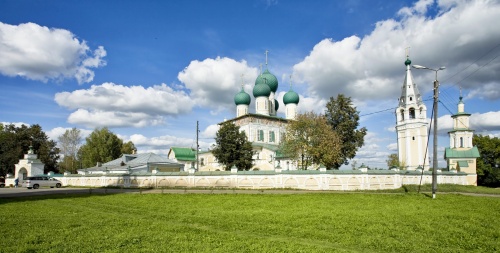Photo excursion - Tutaev Temples (58 photos)
Story
Until the end of the 18th century, the settlements on the opposite banks of the Volga were independent and had their own administrative and economic structures.
The city of Romanov was founded at the end of the 13th century by the Uglich prince Roman Vladimirovich. It was destroyed to the ground during the Mongol-Tatar raid. In 1345, the city was rebuilt and became the center of the small Romanov principality - the possession of Prince Roman (he is often indicated as the founder of the city), the youngest son of the Yaroslavl prince Vasily Davidovich Groznye Ochi, at the same time the city was surrounded by ramparts and wooden walls with four corners and two gate towers. In the center of the city there was a wooden Cathedral Church in honor of the Exaltation of the Holy Cross, built by the Uglich prince, a princely tower and outbuildings. Soon a settlement grew around the fortress. In the 15th century, the principality became part of Moscow. In 1468, Grand Duchess Maria Yaroslavna, whose personal possession the city was then, renewed the defensive structures. In 1472, she transferred the city to the ownership of her son, the Uglich prince Andrei Bolshoi, in connection with whose arrest in 1491, Romanov finally became part of the domain of the Moscow prince.
In the 15th century, the Borisoglebskaya fishing settlement appeared on the opposite bank. In the 16th century, it was assigned to the Moscow Palace Order.
In 1563, by the will of Ivan the Terrible, a massive resettlement of Tatars to Yaroslavl took place. The city of Romanov was completely given over to the Tatar Murzas for two hundred years. According to I. Ya. Gurlyand, professor of the Yaroslavl Demidov Lyceum, “...the settlement of the original Russian area by Tatar immigrants is a kind of historical whim that led to the dominance of the Tatars not only in the Romanovsky, but also in the neighboring Yaroslavl districts...” The state pursued a policy of Christianization of the Tatars. By decree of December 13, 1760, the Romanov Tatars, who refused to convert to Orthodoxy, were resettled to a settlement near Kostroma (to the so-called Black Village). During the stay of the Tatar Murzas, Romanov acquired a Muslim appearance. Several mosques were built on the outskirts of the city. But after the relocation of the Tatars, who were steadfast in their faith, to the outskirts of Kostroma, all the mosques in Romanov were dismantled.
During the Time of Troubles at the beginning of the 16th century, both settlements were plundered and burned.
Shipbuilding developed in Romanov, ships were built - “Romanovkas”, which were distinguished by speed and maneuverability. The fishermen of Borisoglebsk delivered fish to the royal table. Trade flourished in both settlements.
In 1652, in Borisoglebskaya Sloboda, the first stone, tented church in the name of the Smolensk Mother of God was built on the site of a wooden monastery. But it was built poorly and already in 1670 it became unsuitable. In 1678, on its basis, Yaroslavl craftsmen built the most famous temple of the city - the Resurrection Cathedral; around 1680 it was painted by Yaroslavl artists. In 1660, Moscow masons built a more modest Annunciation Church in the southern part of Borisoglebskaya Sloboda. At the same time, the Holy Cross Cathedral was being built in Romanov, replacing a wooden church, also built by Yaroslavl residents, and painted by Yaroslavl and Kostroma painters. A number of other outstanding temples were built in the 17th and 18th centuries. In addition to them, merchants built stone residential buildings.
Ivan Belonogov. View of the district town of Romanov-Borisoglebsk from the southeast side. 1838
In 1777, Romanov and Borisoglebskaya Sloboda (which received the status of the city of Borisoglebsk in honor of this) became the centers of the districts of the Yaroslavl province. At the end of the 18th century, like many Russian cities, Romanov and Borisoglebsk received regular plans, but due to the complexity of the terrain they had little influence.
In 1822, the two cities were united into a single Romanov-Borisoglebsk. But from the beginning of the 19th century, the city began to develop slowly, suppressed by the proximity of the large Yaroslavl, stone construction decreased - during the 19th century not a single outstanding building was created, residential buildings were erected according to “model designs”. However, in some industries, some success has been achieved: in the vicinity of the city, Romanov sheep, famous throughout Russia, are bred, a sheepskin and fur factory appears in the city; The Romanov Flax Manufactory and the Konstantinovsky Mineral Oil Plant operate near the city.
At the beginning of the 20th century, the city had about 8.5 thousand residents who worked in 12 local factories, of which the most important was the Romanov Linen Manufactory Partnership with a turnover of more than a million rubles. Significant factories producing sheepskin have created fame for Romanov-Borisoglebsk for its high quality of processing.
In 1918, Romanov-Borisoglebsk was renamed in honor of ordinary Red Army soldier I.P. Tutaev, who died during the suppression of the Yaroslavl uprising.
The Great Patriotic War did not reach Tutaev, but 22 thousand Tutaevites went to the front.
In the post-war period, the city’s traditional processing industries continued to develop.flax weaving, clothing and furniture production. In the early 1970s, the largest engine plant in the Yaroslavl region was built.
